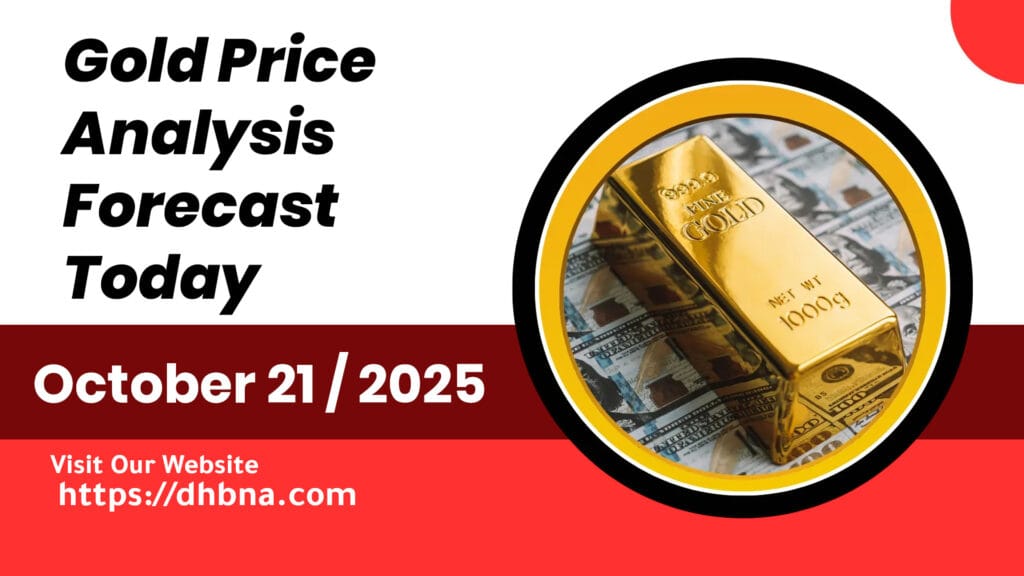As of October 21 2025, gold remains at the center of global market attention. Economic and geopolitical crosswinds have continued to drive its price dynamics. Rising U.S.–China tensions, a temporary U.S. government shutdown, and weakening growth expectations have reinforced gold’s safe-haven appeal. At the same time, investors are closely watching the Federal Reserve, led by Jerome Powell, for cues regarding the next interest-rate decision.
This report, built on the DHBNA methodology, offers a documented, balanced, and data-based analysis through three major lenses: global news, commodity and currency markets, and central-bank policy, followed by a technical overview and forward-looking assessment.
Global News & Indicators
Geopolitical stress remains the most prominent factor behind gold’s resilience. Renewed trade frictions between major economies and fiscal uncertainty in the U.S. have spurred investors to seek safety in tangible assets.
Meanwhile, the Federal Reserve’s Beige Book pointed to moderate business activity, prompting expectations that the Fed could shift toward a more accommodative stance.
Global institutions such as HSBC, ANZ, and Bloomberg Intelligence have raised their medium-term gold forecasts for 2025–2026, citing increased central-bank purchases and a weaker U.S. dollar.
Market analysts warn, however, that if economic conditions stabilize or tensions ease, the metal could enter a phase of consolidation rather than sustained rally.
Commodities, Currencies, and Yields
The U.S. dollar remains the single most significant short-term driver for gold prices. A weaker dollar reduces the relative cost of gold for non-U.S. investors, while strength in the greenback usually pressures the metal.
In parallel, oil prices and inflation expectations play an indirect but meaningful role: higher energy costs often translate to inflation fears, reinforcing gold’s hedge appeal.
U.S. Treasury yields have retreated slightly as investors bet on future rate cuts, reducing real yields and improving the opportunity cost profile for holding gold.
This mix, a softer dollar, lower yields, and ongoing inflationary signals, provides a supportive backdrop for gold. Yet, any abrupt rise in real yields or rebound in the dollar could trigger corrective selling in the short run.
Central-Bank Policy & Monetary Interventions
Central banks worldwide continue to expand their gold reserves as part of diversification strategies, adding structural support to demand.
The Federal Reserve remains pivotal: market participants anticipate a 25-basis-point rate cut in the upcoming FOMC meeting, followed by another later in the year if growth data deteriorates. Such expectations keep real yields compressed and underpin gold’s strength.
Still, risks persist, a hawkish pivot from the Fed, prompted by renewed inflation pressure, could cap further gains.
Elsewhere, the People’s Bank of China and the Reserve Bank of India are also reportedly expanding gold holdings, adding to the underlying bullish tone.
Technical Overview
Technically, gold trades near US$ 4,220, facing resistance between US$ 4,300 – 4,350. Key supports stand at US$ 4,000 and US$ 3,900.
Short-term momentum remains constructive but slightly overbought, while medium-term structure points toward continued upside so long as macro drivers persist.
Forward Outlook
Under the base scenario, characterized by expected Fed easing, stable inflation, and sustained central-bank demand, gold is likely to retain its upward bias.
An alternate scenario of stronger-than-expected U.S. data or a rebound in the dollar could prompt a pullback toward key support zones.
Overall, the balance of probabilities favors gradual appreciation rather than abrupt movement, with volatility remaining elevated.
Neutral Summary
At US$ 4,220.54/oz, gold reflects a complex equilibrium between policy expectations, currency dynamics, and risk sentiment.
The near-term outlook remains constructive but sensitive to macro shifts, particularly U.S. rate decisions and dollar movements.
For investors, a data-driven, non-directional approach is essential: the gold market in late 2025 is best understood as a reflection of uncertainty, rather than a simple bullish or bearish trend.
Discover more from Dhbna
Subscribe to get the latest posts sent to your email.

